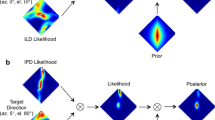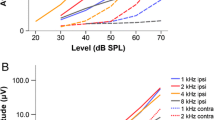Abstract
Interaural time and level differences are important cues for sound localization. We wondered whether the broadband information contained in these two cues could fully explain the behavior of barn owls and responses of midbrain neurons in these birds. To tackle this problem, we developed a novel approach based on head-related transfer functions. These filters contain the complete information present at the eardrum. We selected positions in space characterized by equal broadband interaural time and level differences. Stimulation from such positions provides reduced information to the owl. We show that barn owls are able to discriminate between such positions. In many cases, but not all, the owls may have used spectral components of interaural level differences that exceeded the known behavioral resolution and variability for discrimination. Alternatively, the birds may have used template matching. Likewise, neurons in the optic tectum of the barn owl, a nucleus involved in sensorimotor integration, contained more information than is available in the broadband interaural time and level differences. Thus, these data show that more information is available and used by barn owls for sound localization than carried by broadband interaural time and level differences.











Similar content being viewed by others
References
Alves-Pinto A, Palmer AR, Lopez-Poveda EA (2014) Perception and coding of high-frequency spectral notches: potential implications for sound localization. Front Neurosci 8:112. https://doi.org/10.3389/fnins.2014.00112.eCollection
Anbuhl KL, Benichoux V, Greene NTR, Brown AD, Tollin DJ (2017) Development of the head, pinnae, and acoustical cues to sound location in a precocial species, the guinea pig (Cavia porcellus). Hear Res 356:35–50
Arthur BJ (2004) Sensitivity to spectral interaural intensity difference cues in space-specific neurons of the barn owl. J Comp Physiol A 190:91–104
Bala AD, Spitzer MW, Takahashi TT (2003) Prediction of auditory spatial acuity from neural images on the owl's auditory space map. Nature 424:771–774
Blauert J (1997) Spatial hearing. Revised edition. MIT Press, Cambridge
Brainard MS, Knudsen EI, Esterly SD (1992) Neural derivation of sound source location: resolution of spatial ambiguities in binaural cues. J Acoust Soc Am 91:1015–1027
Bremen P, Poganiatz I, von Campenhausen H, Wagner H (2007) Sensitivity to interaural time difference and representation of azimuth in central nucleus of inferior colliculus in the barn owl. J Comp Physiol A 193:99–112
Cazettes F, Fischer BJ, Pena JL (2014) Spatial cue reliability drives frequency tuning in the barn owl's midbrain. eLife 3:e04854
Cazettes F, Fischer BJ, Pena JL (2016) Cue reliability represented in the shape of tuning curves in the owl’s sound localization system. J Neurosci 36:2101–2110
Cazettes F, Fischer BJ, Beckert MV, Pena JL (2018) Emergence of an adaptive command from orienting behaviour in premotor brainstem neurons of barn owls. J Neurosci 38:7270–7279
Day ML, Delgutte B (2013) Decoding sound source location and separation using neural population activity patterns. J Neurosci 33:15837–15847
De Bello WM, Knudsen EI (2004) Multiple sites of adaptive plasticity in the owl's auditory localization pathway. J Neurosci 24:6853–6861
Dietz M, Lestang JH, Majdak P, Stern RM, Marquardt T, Ewert SD, Hartmann WM, Goodman DFM (2018) A framework for testing and comparing binaural models. Hear Res 360:92–106
Du Lac S, Knudsen EI (1990) Neural maps of head movement vector and speed in the optic tectum of the barn owl. J Neurophysiol 63:131–146
Dyson ML, Klump GM, Gauger B (1998) Absolute hearing thresholds and critical masking ratios in the barn owl: a comparison with other owls. J Comp Physiol A 182:695–702
Egnor R (2001) Effects of binaural decorrelation on neural and behavioral processing of interaural level differences in the barn owl (Tyto alba). J Comp Physiol A 187:589–595
Euston DR, Takahashi TT (2002) From spectrum to space: the contribution of level difference cues to spatial receptive fields in the barn owl inferior colliculus. J Neurosci 22:284–293
Ferger R, Pawlowsky K, Singheiser M, Wagner H (2018) Response adaptation in the barn owl's auditory space map. J Neurophysiol 119:1235–1247
Fischer BJ, Pena JL (2011) Owl's behavior and neural representation predicted by Bayesian inference. Nat Neurosci 14:1061–1066
Fischer BJ, Pena JL (2017) Optimal nonlinear cue integration for sound localization. J Comput Neurosci 42:37–52. https://doi.org/10.1007/s10827-016-0626-4
Grothe B (2018) How the barn owl computes auditory space. Trends Neurosci 41:115–117. https://doi.org/10.1016/j.tins.2018.01.004
Hausmann L, von Campenhausen M, Endler F, Singheiser M, Wagner H (2009) Improvements of sound localization abilities by the facial ruff of the barn owl (Tyto alba) as demonstrated by virtual ruff removal. PLoS One 4:e7721
Keating P, Nodal FR, Gananandan K, Schulz AL, King AJ (2013) Behavioral sensitivity to broadband binaural localization cues in the ferret. J Assoc Res Otolaryngol 14:561–572
Keating P, Nodal FR, King AJ (2014) Behavioural sensitivity to binaural spatial cues in ferrets: evidence for plasticity in the duplex theory of sound localization. Eur J Neurosci 39:197–206
Keller CH, Hartung K, Takahashi TT (1998) Head-related transfer functions of the barn owl: measurement and neural responses. Hear Res 118:13–34
Kettler L, Griebel H, Ferger R, Wagner H (2017) Combination of interaural level and time difference in azimuthal sound localization in owls. eNeuro 4:1–13. https://doi.org/10.1523/ENEURO.0238-17.2017
Knudsen EI (1982) Auditory and visual maps of space in the optic tectum of the owl. J Neurosci 2:1177–1194
Knudsen EI, Konishi M (1978) A neural map of auditory space in the owl. Science 200:795–797
Knudsen EI, Blasdel GG, Konishi M (1979) Sound localization by the barn owl measured with the search coil technique. J Comp Physiol 133:1–11
Koka K, Jones HG, Thornton JL, Lupo JE, Tollin DJ (2011) Sound pressure transformations by the head and pinnae of the adult Chinchilla (Chinchilla lanigera). Hear Res 272:135–147
Koka K, Read HL, Tollin DJ (2008) The acoustical cues to sound location in the rat: measurements of directional transfer functions. J Acoust Soc Am 123:4297–4309
Konishi M (1973) How the owl tracks its prey. Am Sci 61:414–424
Konishi M, Kenuk AS (1975) Discrimination of noise spectra by memory in the barn owl. J Comp Physiol 97:55–58
Krumm B, Klump GM, Koeppl C, Langemann U (2019) The barn owls‘ minimum audible angle. PLos One 14(8):e0220652
Majdak P, Walder T, Laback B (2013) Effect of long-term training on sound localization performance with spectrally warped and band-limited head-related transfer functions. J Acoust Soc Am 134:2148–2159
Middlebrooks JC (2015) Sound localization. Handb Clin Neurol 129:99–116
Mogdans J, Knudsen EI (1992) Adaptive adjustment of unit tuning to sound localization cues in response to monaural occlusion in developing owl optic tectum. J Neurosci 12:3473–3484
Moiseff A (1989a) Binaural disparity cues available to the barn owl for sound localization. J Comp Physiol A 164:629–636
Moiseff A (1989b) Bi-coordinate sound localization by the barn owl. J Comp Physiol A 164:637–644
Moiseff A, Konishi M (1981) Neuronal and behavioral sensitivity to binaural time differences in the owl. J Neurosci 1:40–48
Olsen JF, Knudsen EI, Esterly SD (1989) Neural maps of interaural time and intensity differences in the optic tectum of the barn owl. J Neurosci 9:2591–2605
Poganiatz I, Wagner H (2001) Sound-localization experiments with barn owls in virtual space: influence of broadband interaural level difference on head-turning behavior. J Comp Physiol A 187:225–233
Poganiatz I, Nelken I, Wagner H (2001) Sound-localization experiments with barn owls in virtual space: influence of interaural time difference on head-turning behavior. J Ass Res Otolaryng 2:1–21
Quine DB, Konishi M (1974) Absolute frequency discrimination in the barn owl. J comp Physiol 93:347–360
Rice JJ, May BJ, Spirou GA, Young ED (1992) Pinna-based spectral cues for sound localization in cat. Hear Res 58:132–152
Schnyder HA, Vanderelst D, Bartenstein S, Firzlaff U, Luksch H (2014) The avian head induces cues for sound localization in elevation. PLoS One 9:e112178
Singheiser M, Plachta DTT, Brill S, Bremen P, van der Willigen R, Wagner H (2010) Target-approaching behavior of barn owls (Tyto alba): influence of sound frequency. J Comp Physiol A 196:227–240
Slee SJ, Young ED (2010) Sound localization cues in the marmoset monkey. Hear Res 260:96–108
Spezio ML, Takahashi TT (2003) Frequency-specific interaural level difference tuning predicts spatial response patterns of space-specific neurons in the barn owl inferior colliculus. J Neurosci 23:4677–4688
Spezio ML, Keller CH, Marrocco RT, Takahashi TT (2000) Head-related transfer functions of the Rhesus monkey. Hear Res 144:73–88
Sterbing SJ, Hartung K, Hoffmann KP (2003) Spatial tuning to virtual sounds in the inferior colliculus of the guinea pig. J Neurophysiol 90:2648–2659
Takahashi TT (2010) How the owl tracks its prey–II. J Exp Biol 213:3399–3408. https://doi.org/10.1242/jeb.031195
Van Opstal AJ, Vliegen J, van Esch T (2017) Reconstructing spectral cues for sound localization from responses to rippled noise stimuli. PLoS One 12:e0174185
von Campenhausen M, Wagner H (2006) Influence of the facial ruff on the sound-receiving characteristics of the barn owl's ears. J Comp Physiol A 192:1073–1082
Vonderschen K, Wagner H (2009) Tuning to interaural time difference and frequency differs between the auditory arcopallium and the external nucleus of the inferior colliculus. J Neurophysiol 101:2348–2361
Wagner H (1993) Sound-localization deficits induced by lesions in the barn owl's space map. J Neurosci 13:371–386
Wagner H, Asadollahi A, Bremen P, Endler F, Vonderschen K, von Campenhausen M (2007) Distribution of interaural time difference in the barn owl’s inferior colliculus in the low- and high-frequency ranges. J Neurosci 27:4191–4200
Wagner H, Kettler L, Orlowski J, Tellers P (2013) Neuroethology of prey capture in the barn owl (Tyto alba L.). J Physiol (Paris) 107:51–61
Wightman FL, Kistler DJ (1989a) Headphone simulation of free field listening. I: stimulus synthesis. J Acoust Soc Am 85:858–867
Wightman FL, Kistler DJ (1989b) Headphone simulation of free-field listening. II: Psychophysical validation. J Acoust Soc Am 85:868–878
Wood KC, Town SM, Bizley JK (2019) Neurons in primary auditory cortex represent sound source location in a cue-invariant manner. Nat Commun 10:3019. https://doi.org/10.1038/s41467-019-10868-9
Young ED, Rice JJ, Tong SC (1996) Effects of pinna position on head-related transfer functions in the cat. J Acoust Soc Am 99:3064–3076
Acknowledgements
Kira Zeevaert helped with owl training. Lisanne Schulten helped with electrophysiological experiments. Brian Fischer gratefully provided the data and code for the variability analysis. The comments by Lutz Kettler, Thomas Künzel and Jose Pena on an earlier version of the manuscript helped a lot to improve the manuscript. This research was sponsored by a grant of the German science foundation (DFG) to HW (Wa606/26-1) and Hartmut Führ (Fu402/6-1). HW was further supported by the German Research Foundation (DFG) through grant number 368482240/GRK2416.
Author information
Authors and Affiliations
Corresponding author
Ethics declarations
Conflict of interest
The authors declare that they have no conflict of interest.
Additional information
Publisher's Note
Springer Nature remains neutral with regard to jurisdictional claims in published maps and institutional affiliations.
Rights and permissions
About this article
Cite this article
Schillberg, P., Brill, S., Nikolay, P. et al. Sound localization in barn owls studied with manipulated head-related transfer functions: beyond broadband interaural time and level differences. J Comp Physiol A 206, 477–498 (2020). https://doi.org/10.1007/s00359-020-01410-0
Received:
Revised:
Accepted:
Published:
Issue Date:
DOI: https://doi.org/10.1007/s00359-020-01410-0




